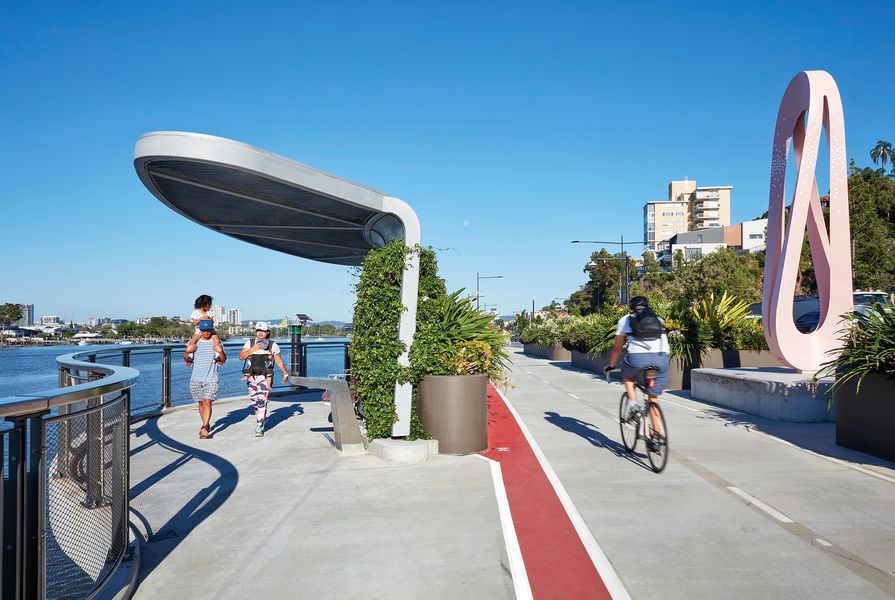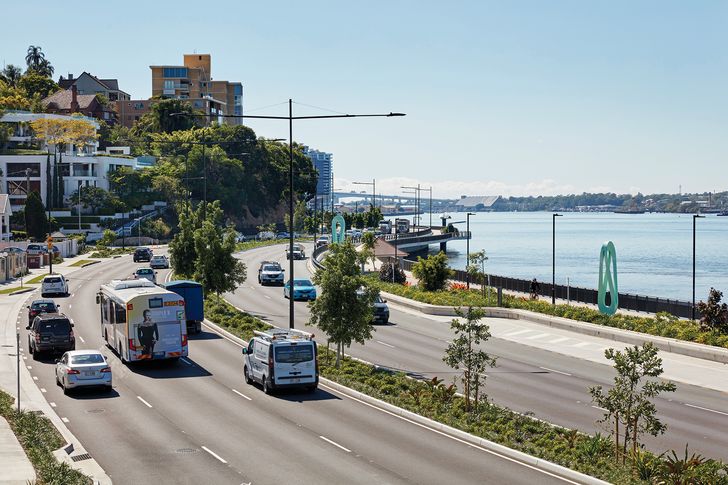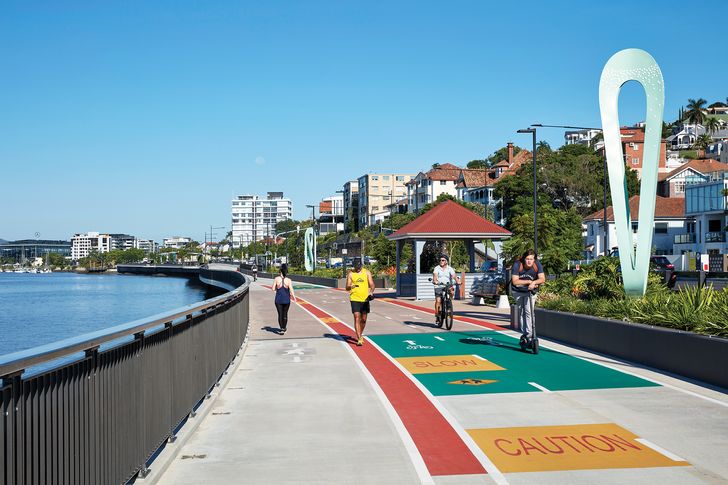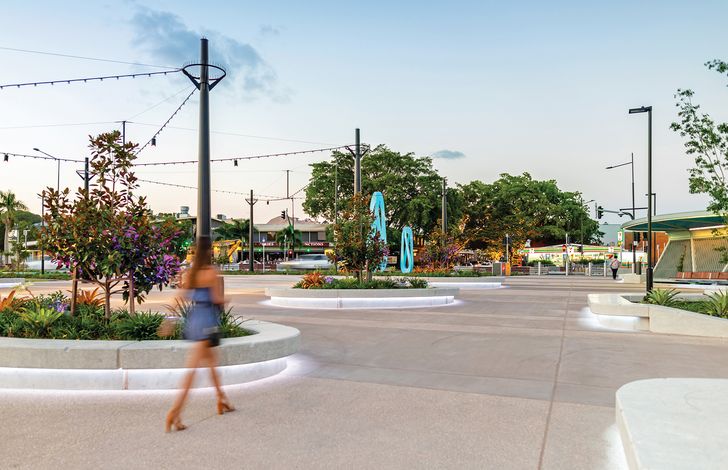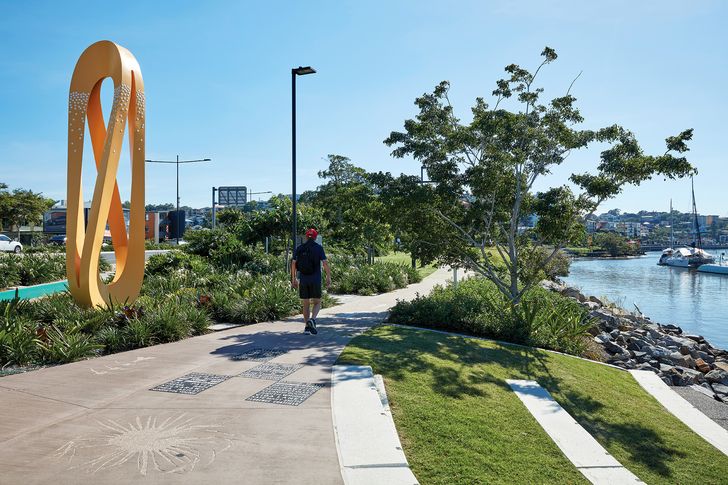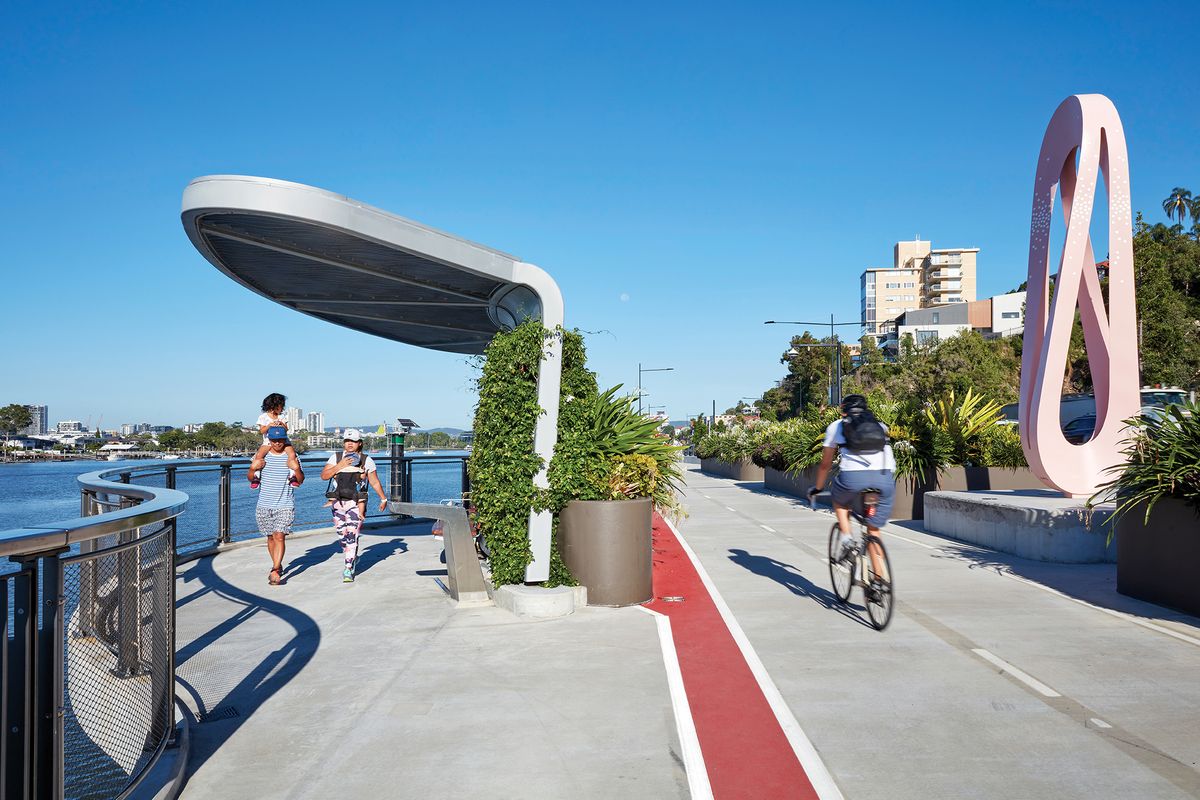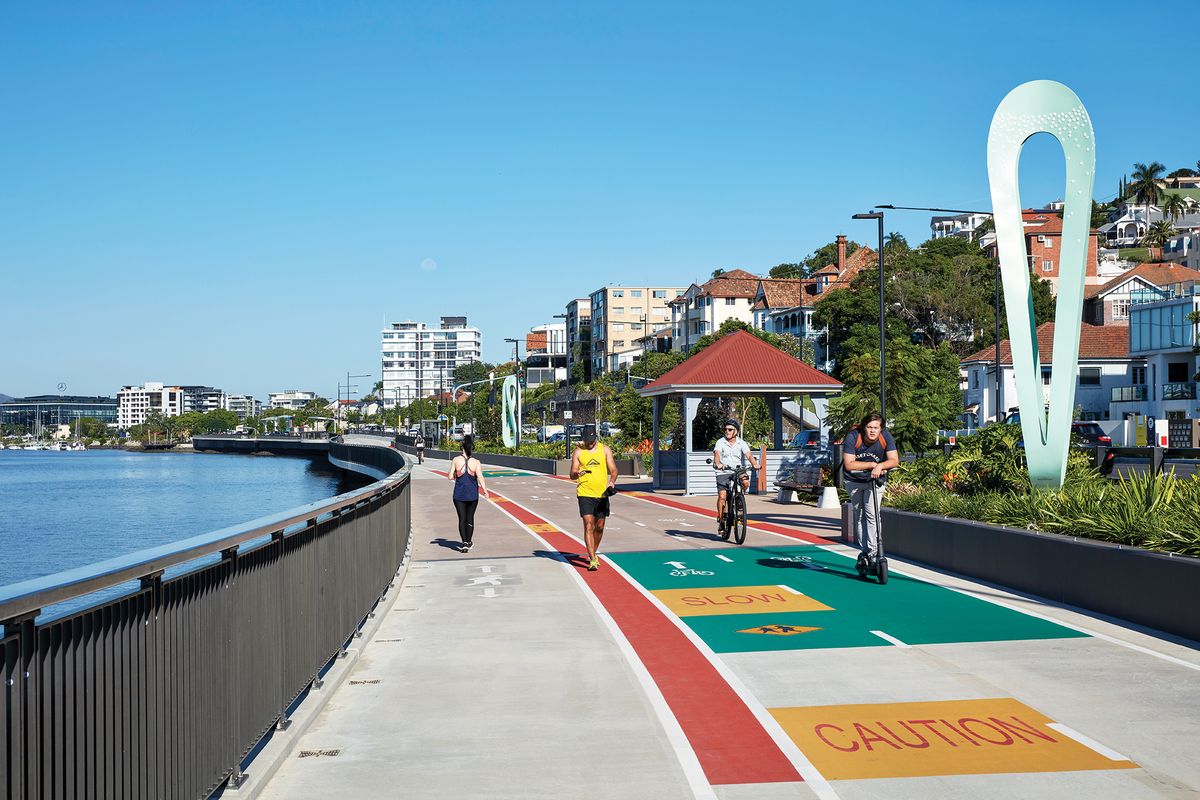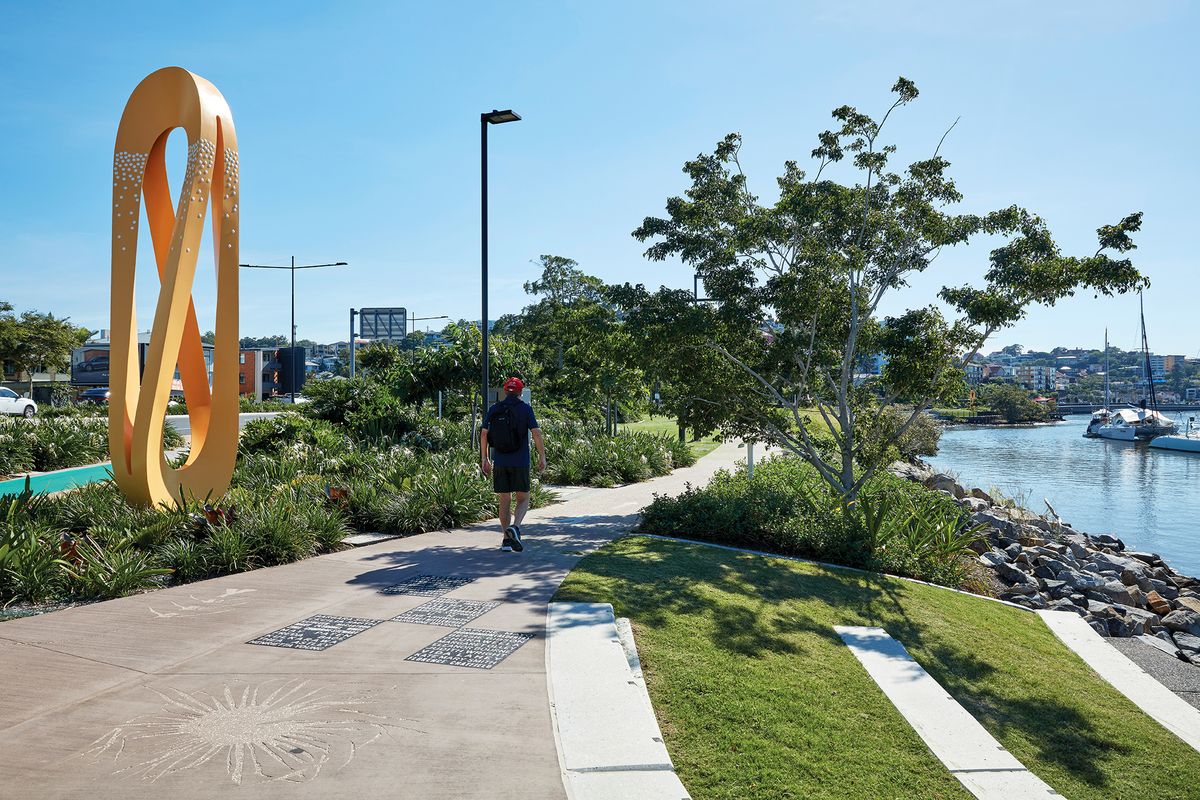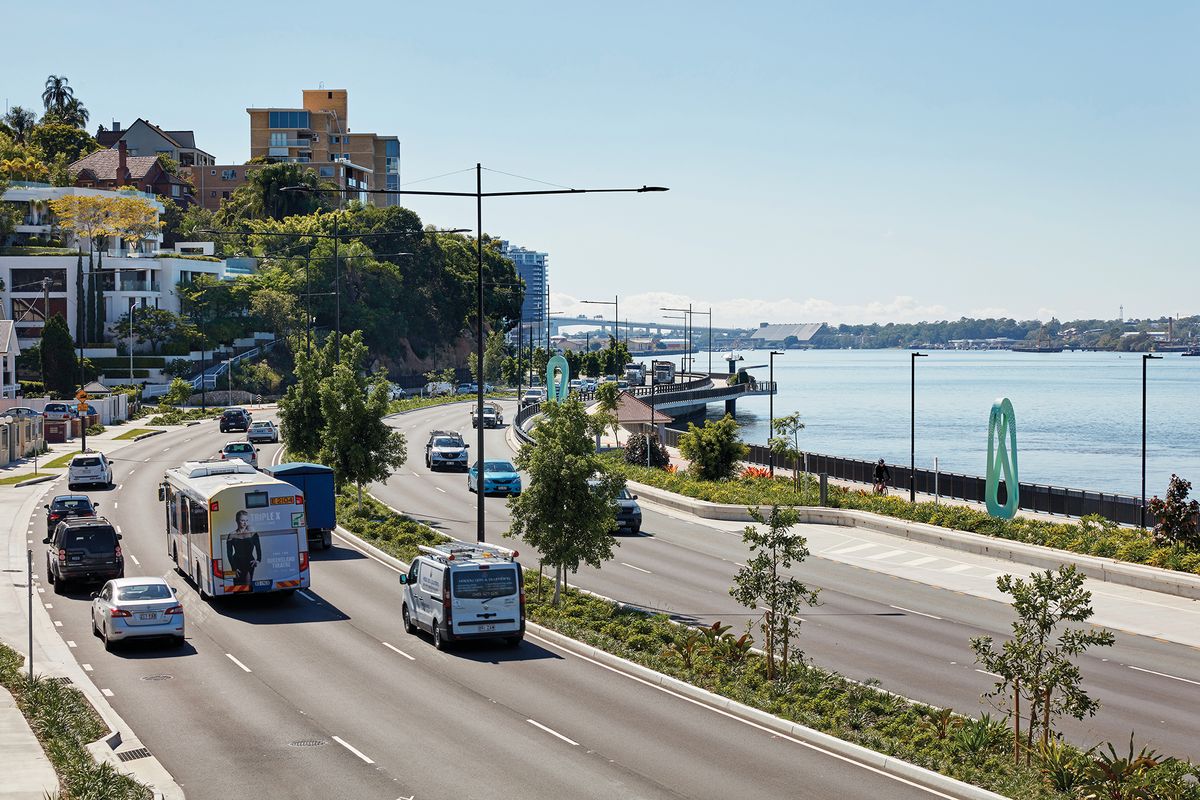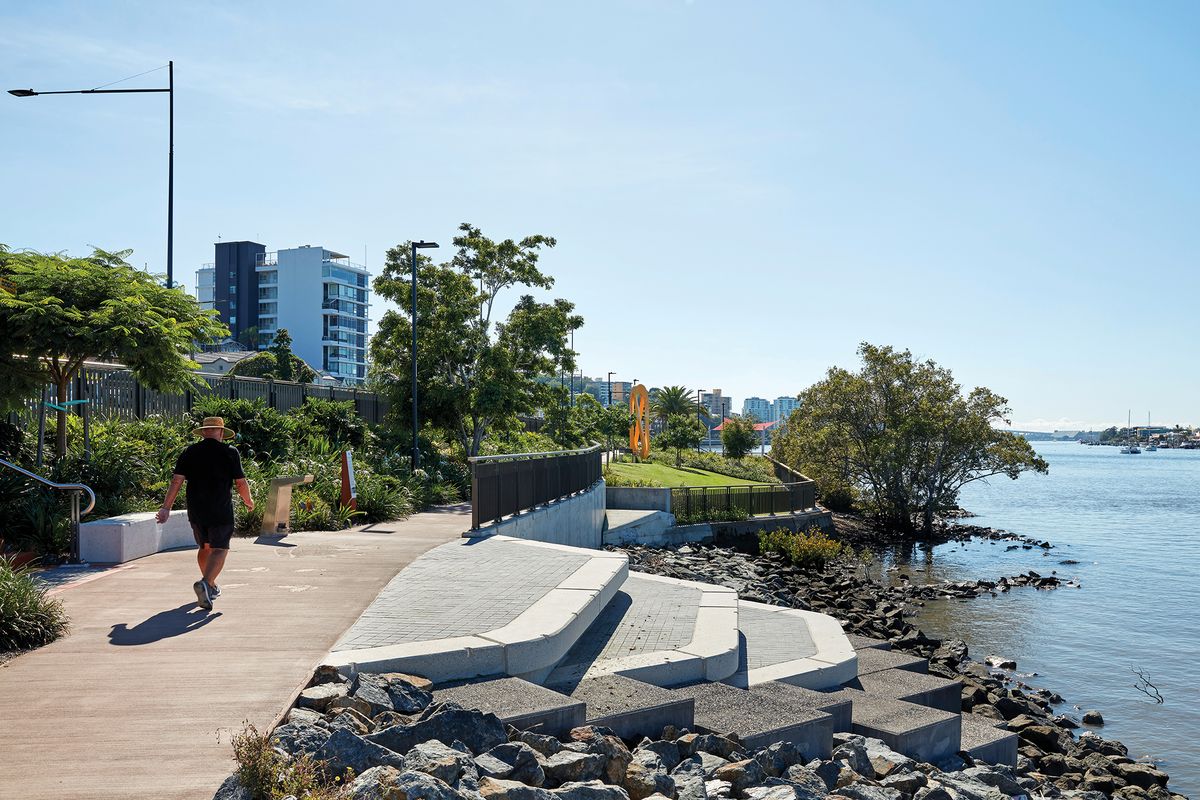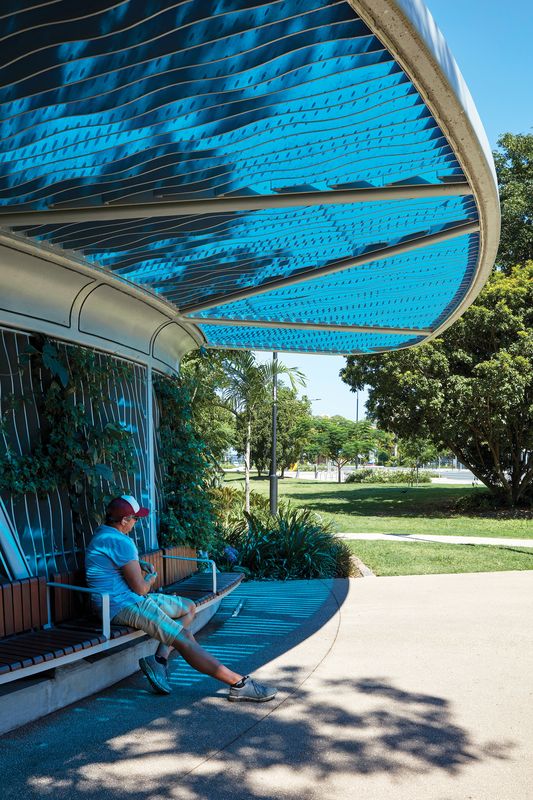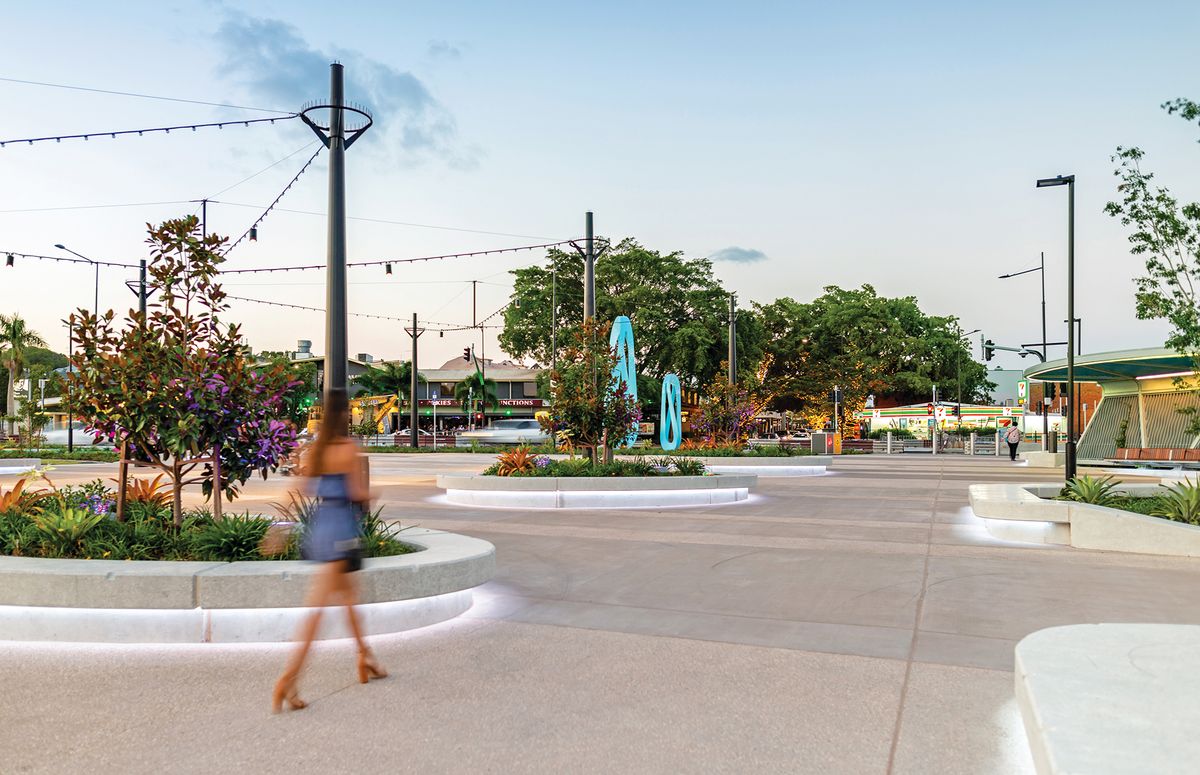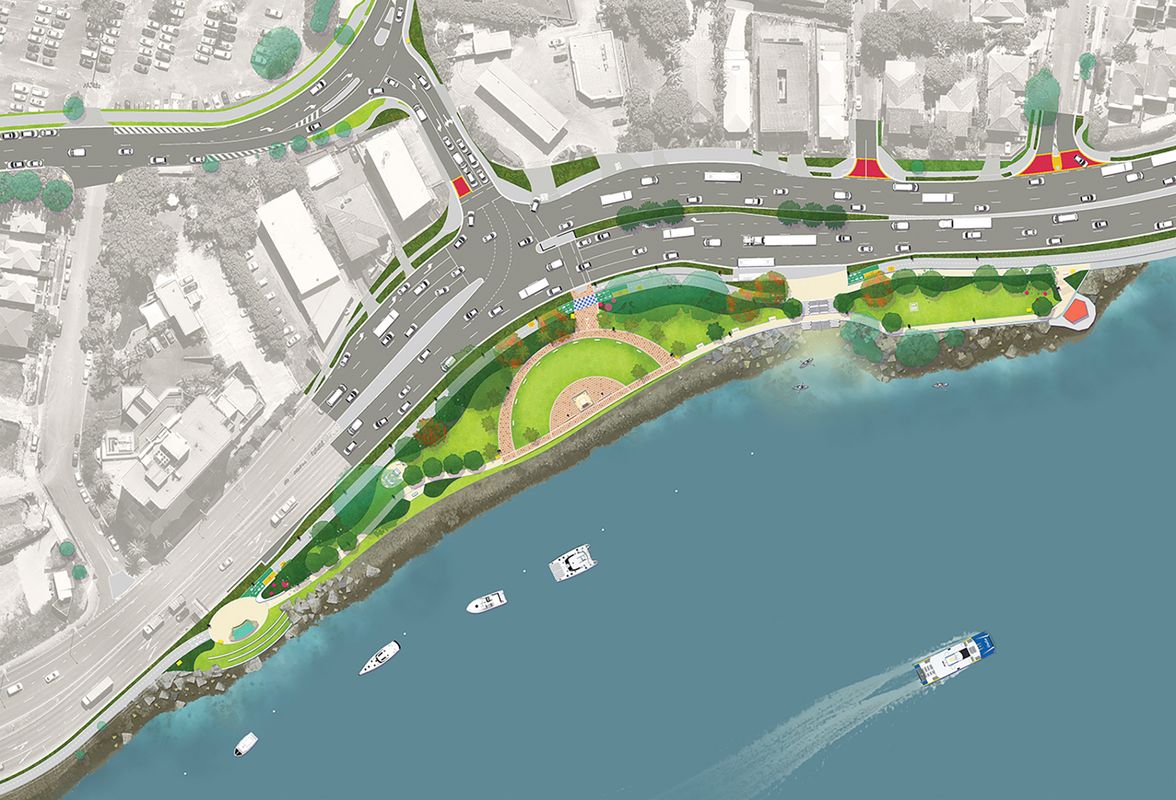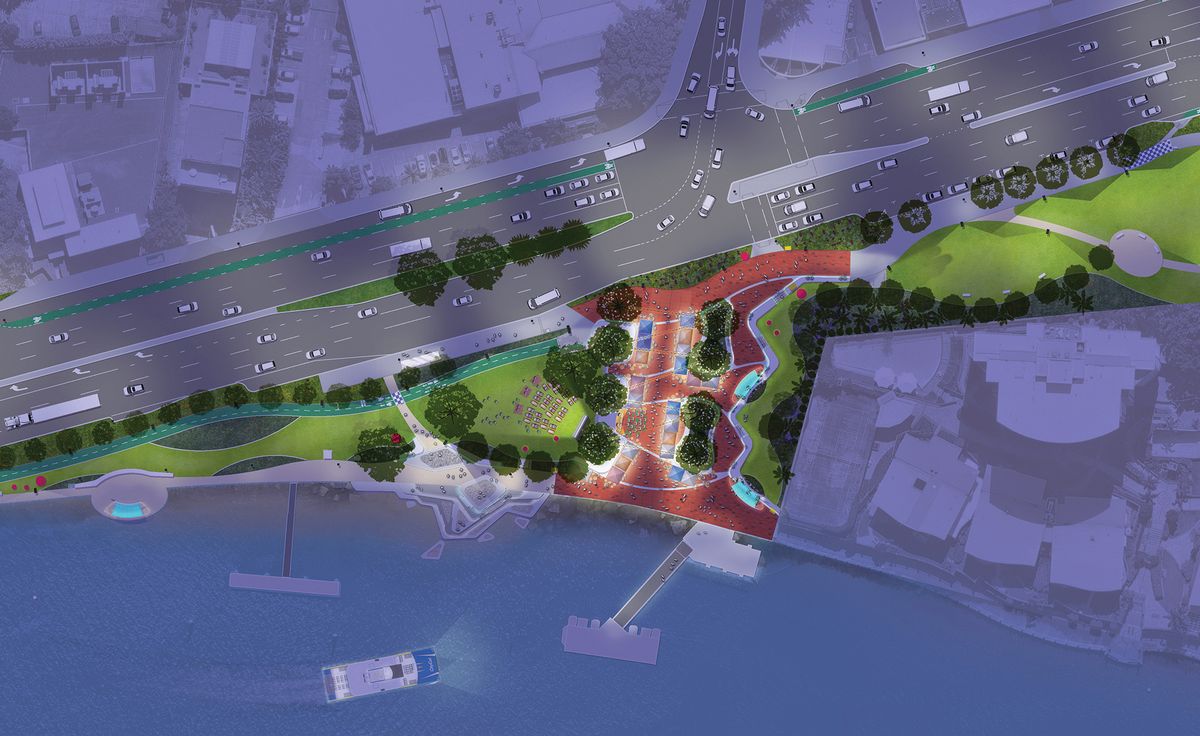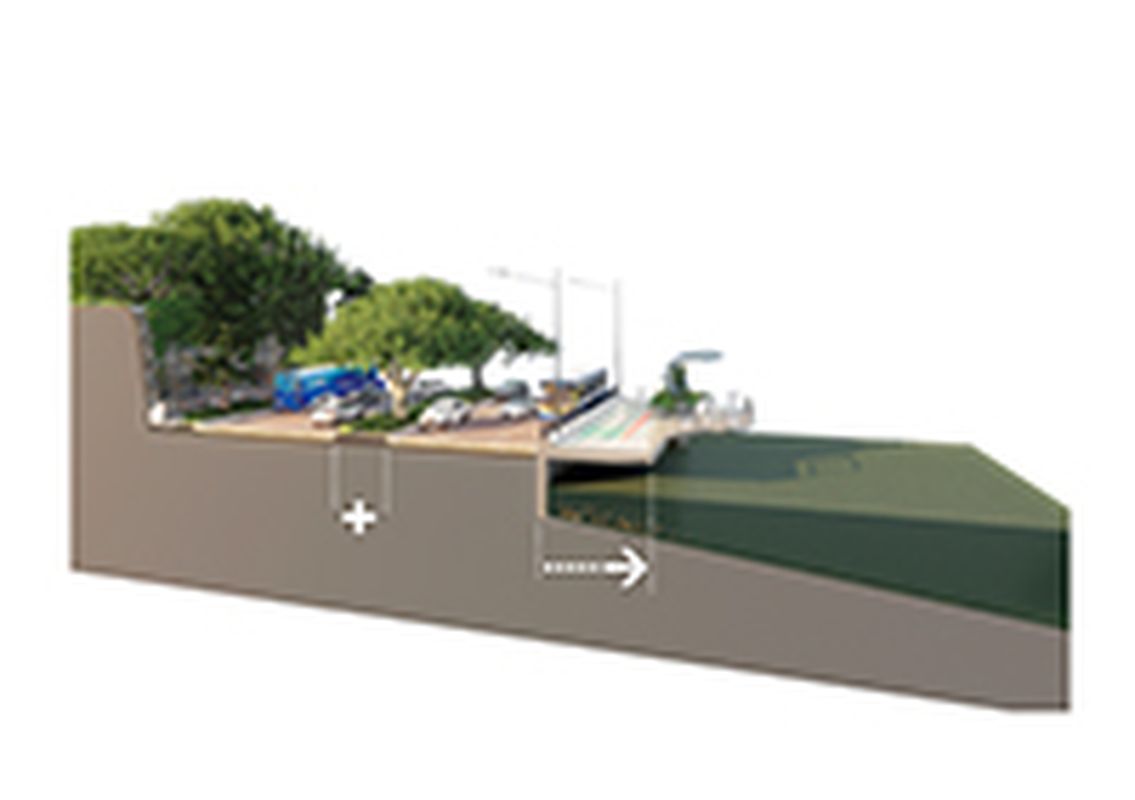Brisbane considers itself a “river city” and Indigenous peoples have occupied its riverine landscapes for tens of thousands of years. After European encroachment in 1823, the development of the Brisbane River followed the trajectory of industrial-era cities the world over, with shipping, industry, roads and rail lining the banks of the lower reaches. In recent times, such cities have sought to re-engage their populaces with these riverbanks, and in Brisbane this was embarked upon with the hosting of World Expo 88 at what is now South Bank Parklands.
A thread runs from this event to the Kingsford Smith Drive (KSD) upgrade project, which is part of the 2013 Brisbane City Council River’s Edge Strategy guiding the connection and activation of the river’s inner-city reaches and stitching together a continuous public river edge domain. KSD is an arterial road connecting the CBD with the city’s north-east, running partially alongside the river. In 2016, Lendlease Engineering won the tender to realize Brisbane City Council’s brief to widen KSD from four to six lanes, creating “a subtropical gateway boulevard into the city.” KSD, named after the aviator Sir Charles Kingsford Smith, is bounded to the north by low cliffs, partially retained by heritage-listed walls supporting heritage-listed houses. Road widening therefore necessitated pushing south onto land adjacent to the river. The project encompasses 3.3 kilometres of road divided into two sections, with the focus of this review being on the 1.2-kilometre western section of public river edge domain designed by Lat27, which opened in 2020. Here the design strategy was to cantilever a pedestrian and cycle path out over the river, anchoring it at each end with public open spaces providing access to the water. The cantilevering enabled the otherwise impossible creation of a KSD median strip planted with large native figs and kauri pines to enhance the road as a city gateway.
As part of the upgrade, a median strip planted with native figs and kauri pines has been created along Kingsford Smith Drive, enhancing the entryway into the city.
Image: Christopher Frederick Jones
Reading the pedestrian and cycle path’s didactic signage, one gets a rare glimpse of some of the women who were part of the history of this place. Quandamooka woman Oodgeroo Noonuccal, who controversially accepted the job of scriptwriting a performance for the Bicentenary celebrations of World Expo 88 acknowledging Indigenous Australians as the nation’s first inhabitants, is included in an artwork etched into the ground at either end of this project’s cantilevered path. The artwork, a list of significant women from the Brisbane region, was created by Waanyi woman and artist Judy Watson and is aptly titled Bandarra-gan chidna: strong woman track/track of strong women. Watson’s artwork also depicts the floorplan of the former Eagle Farm Women’s Prison, whose inmates, according to some accounts, cut the area’s first road (which later became KSD) in 1829–30. Finally, the new cantilevered path is named the Lores Bonney Riverwalk after the pioneering aviatrix, who learnt to fly at nearby Eagle Farm airport in the 1930s.
A seven-metre-wide path cantilevers out over the river, separating cyclist and pedestrian routes along Kingsford Smith Drive.
Image: Christopher Frederick Jones
At Bretts Wharf Plaza, at the east end of the Riverwalk, vibrant garden beds and catenary lighting create an after-dark gathering and event space.
Image: Christopher Frederick Jones
In addition to sensitively engaging with the area’s history, the Riverwalk has made it considerably safer and more pleasant for cyclists and pedestrians to traverse KSD. The cantilever reaches an impressive seven-metre width, enabling separation of the two modes of transit. It is bookended to the east by the multipurpose event space of Bretts Wharf Plaza, where garden beds are surprisingly lush considering the roadside conditions and minimal irrigation, and a ring of catenary lighting effectively creates an after-dark focal centre. Walking west, a recreation “hub” features blocky articulated steps leading down to the river’s edge, away from traffic noise. Along its length, the Riverwalk is dotted with shelters built out over the river approximately every 120 metres, integrating planting within an organic architectural form that provides welcome shade, water and seating. Charmingly, at the midway Crescent Road node, a refurbished original KSD tram shelter is set amid garden beds. Road-widening excavation unearthed original tram tracks, which Lat27 refashioned into elegant seating benches. Also dotted along the Riverwalk are sculptor Kenji Uranishi’s Magnificent Flying Machines. These massive pastel-coloured beacons provide distinctive wayfinding markers. To the west, the Riverwalk is bookended by the rejuvenated Cameron Rocks Reserve, where two areas of interlocking slab steps lead down into the river, a level of contact rarely facilitated this close to the CBD.
Kenji Uranishi’s sculptural Magnificent Flying Machines line the path and function as wayfinding markers along the river
Image: Christopher Frederick Jones
Light filters through the curved forms of the shade shelters, casting coloured patterns on the ground plane.
Image: Christopher Frederick Jones
Some aspects of the plan are less successful, however. The lack of shade along the Riverwalk is disappointing in a place where the sun can be brutal, and the glare from the pale concrete path is high. There are several reasons for this. Planting trees along the roadside edge of the Riverwalk was prohibited by the extent of underground structure needed to retain a new river wall and the cantilever backspan. Where there was space for planting, challenging substrate conditions made only minimal soil volumes possible. The provision of shade via more built structures was constrained by the project budget, and residents on the northern side of KSD were vocal in their opposition to the blocking of river views. The cost of colouring through the depth of the pale concrete was also prohibitive. While Lat27 is to be congratulated for what it has achieved within extraordinarily tight constraints, it is to be hoped that in the future, this valuable piece of public infrastructure will be provisioned with more shade.
Since the project opened, Lat27 has conducted informal vox pops along the Riverwalk, finding responses overwhelmingly positive despite the intermittent shade and proximity to traffic. Locals still remember when to walk or cycle along KSD was to traverse a broken, narrow path right beside the traffic. Now, they have room to travel at a safe distance from the road, and they can see and occasionally touch the river.
Heading back east along the “strong woman track” of the Riverwalk, a bus shelter bears a sign that reads, “Next time you see women being disrespected: Do something.” The KSD upgrade is noteworthy for making the statement, albeit symbolic, that women’s contributions to our history and landscapes matter.
Plant list (partial list – key species only)
Trees: Agathis robusta (Queensland kauri pine)*, Brachychiton acerifolius (Illawarra flame tree), Buckinghamia celsissima (ivory curl tree), Colvillea racemosa (Colville’s glory), Delonix regia (poinciana), Elaeocarpus eumundi (Eumundi quandong), Ficus benghalensis (banyan), Ficus benjamina (weeping fig), Ficus microcarpa var. hillii (Hill’s weeping fig)*, Flindersia bennettiana (Bennett’s ash), Flindersia schottiana (bumpy ash), Harpullia pendula (tulipwood), Handroanthus impetiginosus (pink trumpet tree), Hibiscus tiliaceus (cotton tree), Jacaranda mimosifolia (jacaranda), Magnolia grandiflora (southern magnolia), Plumeria obtusa (evergreen frangipani), Polyalthia longifolia ‘Pendula’ (Indian mast tree), Tabebuia aurea (silver trumpet tree), Xanthostemon chrysanthus (golden penda)
Palms: Archontophoenix alexandrae (Alexander palm), Carpentaria acuminata (Darwin palm), Livistona australis (cabbage-tree palm), Rhapis excelsa (lady palm), Wodyetia bifurcata (foxtail palm)*
Shrubs: Carissa macrocarpa ‘Desert Star’ (natal plum)*, Monstera deliciosa (fruit salad plant), Philodendron bipinnatifidum (lacy philodendron)*, Philodendron bipinnatifidum ‘Hope’ (hope philodendron), Strelitzia parvifolia var. juncea (narrow-leaved bird of paradise), Strelitzia reginae (bird of paradise)*, Strelitzia reginae ‘Mandela’s Gold’ (yellow bird of paradise), Zamia furfuracea (cardboard palm)*
Feature plants/bromeliads: Aechmea blanchetiana ‘Rubra’ (Blanchet’s aechmea)*, Aechmea mulfordii (living vase bromeliad), Alcantarea extensa (white empress)*, Alcantarea imperialis ‘Silver Plum’ (empress of Brazil)*, Doryanthes palmeri (giant spear lily), Neoregelia compacta (bleeding heart bromeliad), Neoregelia ‘Bossa Nova’ (Bossa Nova bromeliad), Neoregelia mcwilliamsii ‘Sheba’ (Sheba bromeliad)
Small plants/groundcovers: Crinum pedunculatum (swamp lily)*, Dietes bicolor (yellow wild iris)*, Dietes grandiflora (wild iris)*, Habranthus robustus (rain lily), Hippeastrum (red hippeastrum), Hymenocallis littoralis (beach spider lily)*, Hymenocallis sp. ‘Cayman Giant’ (giant spider lily), Lepidozamia peroffskyana (pineapple zamia), Liriope ‘Stripey White’ (variegated liriope), Liriope muscari ‘Just Right’ (Just Right liriope)*, Lomandra hystrix (green mat-rush), Microsorum puncatum (climbing bird’s nest), Myoporum boninense (mangrove boobillia), Ophiopogon japonicus ‘Nana’ (mini mondo grass), Philodendron ‘Rojo Congo’ (red philodendron), Thaumatophyllum xanadu (xanadu philodendron)*, Trachelospermum asiaticum (Japanese star jasmine), Tradescantia spathacea ‘Hawaiian Dwarf’ (dwarf Moses-in-a-cradle), Zephyranthes candida (white rain lily), Zephyranthes flavissima (yellow rain lily)
Climbers: Cissus rhombifolia (grape ivy)*, Chonemorpha fragrans (climbing frangipani), Pandorea jasminoides ‘Lady Di’ (bower vine)*, Distictis buccinatoria (Mexican blood trumpet), Petrea volubilis (sandpaper vine)
*Signature species
Credits
- Project
- Kingsford Smith Drive Upgrade
- Design practice
- Lat27
Brisbane, Qld, Australia
- Project Team
- John Ilett (project director), Wendy Davies (project manager), Kate Songhurst, Bryce Foster, Alice Laurie, Georgina Pratten, Sasha Paterson, Merrille Antalan
- Consultants
-
Architectural lighting
Design Stage
Design and construct Lendlease Engineering
Engineer Jacobs KBR Kingsford Smith Drive Design Joint Venture
Horticulture Asset Horticultural Consultants
Public artwork strategy and curation Creativemove
Signage, wayfinding and heritage interpretation dotdash
- Aboriginal Nation
- Built on the land of the Yugara/Yugarapul people and Turrbal people
- Site Details
-
Site type
Urban
- Project Details
-
Status
Built
Design, documentation 48 months
Construction 53 months
Category Landscape / urban
Type Public / civic
- Client
-
Client name
Brisbane City Council
Website https://www.brisbane.qld.gov.au/
Source
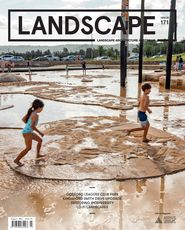
Review
Published online: 10 Sep 2021
Words:
Shannon Satherley
Images:
Christopher Frederick Jones,
Lat27
Issue
Landscape Architecture Australia, August 2021

